Local Civic Groups Are Working to Make The Quad-Cities an Even More Special Place
Saturday in the Arts is a weekly feature covering a trend, subject, event or personality of local interest. It runs every Saturday morning on  your site for the best entertainment and arts coverage in the area, QuadCities.com!
your site for the best entertainment and arts coverage in the area, QuadCities.com!
Kyle Carter and Geoff Manis are two of the biggest cheerleaders for the Quad-Cities, and within two days of each other this month, they sang the praises on social media of placemaking – the long, arduous, gratifying task of creating and sustaining a unique, impressive, growing community.
Carter, executive director of the Downtown Davenport Partnership, posted on Facebook Sept. 19:
“The term ‘placemaking’ can be hard to grasp initially, but this weekend defined it beautifully. K-Square’s rebirth and beautification, an exciting new outdoor venue in LeClaire, Blues Fest on the riverfront, and Riverssance in the Village epitomize why this is so important. I had a blast this weekend in the QC, and this is still only a fraction of what was going on.”
Geoff Manis, Main Street program manager for the city of Moline, posted Sept. 17 that placemaking “creatively complements a community’s assets, inspiration, and potential, with the intention of creating public spaces that promote peopl
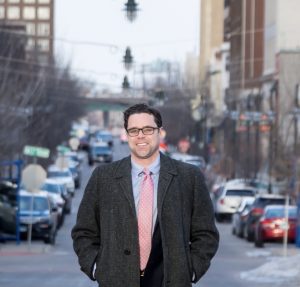
Geoff Manis, Main Street program manager for the city of Moline.
e’s health, happiness, and well-being.”
He posted photos of some placemaking efforts that have been completed just within the last year in downtown Moline – including Bass Street Landing and colorful murals. “Creating an area of the Quad Cities where ALL citizens feel welcome, safe, and vibrant is our number-one priority at the Moline Centre,” Manis wrote, with the hashtag “#bestisyettocome.”
Working in partnership with the Quad Cities Chamber, Quad City Arts, Renew Moline, Development Association of Rock Island, and many other groups, each of the main cities in the area have certainly made huge strides in the past 30-plus years in reimagining and redefining what is special about each community.
But with the recent adoption of Moline’s ambitious Public Art and Placemaking Plan, and moves by each downtown organization in Moline, Rock Island, Davenport, and Bettendorf, there is much momentum to keep the placemaking train on track, boosting its speed, power and influence.
“Placemaking is taking a front-and-center position at the Chamber of Commerce, and extensions of the chamber have already had great success in placemaking,” Kevin Maynard, executive director of Quad City Arts, told a morning network Chamber meeting Sept. 15 on arts and culture.
New downtown Rock Island director, Jack Cullen (under the Chamber), “understands the power of the arts and placemaking,” Maynard said. He was thrilled with last month’s unveiling of a big spray-painted mural at 313 20th St., Rock Island, by 16-year-old Rocky student Riley
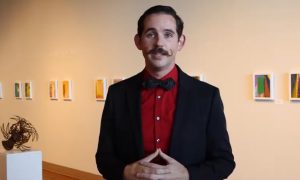
Quad City Arts executive director Kevin Maynard.
Jones.
They’re in discussion on future mural projects, as well as incorporating the arts into infrastructure redesigns.
“That mural also helped to activate an alley and after cleaning up that alley, it’s also a point of pride for those businesses that are moving in,” Maynard said.
“The arts are important,” he said. “The Chamber of Commerce has a goal of attracting talent – specifically younger talent. In a recent study, public art and placemaking are more important to younger demographics when making decisions about where to live and work, specifically referring to millennials and Gen Z-ers.
“In short, everyone wants to live in a cool place an arts and culture are the ticket to get there,” he said. “Thankfully, we live in a region that is doing more to prioritize public art and placemaking.”
Maynard’s favorite definition of placemaking is that it “inspires people to collectively reimagine and reinvent public spaces at the heart of every community.”

Tyson Danner is executive director of River Music Experience, Davenport.
“Strengthening connections between people and the places they share, placemaking refers to a collaborative process,” he said. “By which we can shape our public realm, in order to maximize shared value. More than just promoting better urban design, placemaking facilitates creative patterns of use – paying particular attention to the physical, cultural and social identities that define a place and its ongoing evolution.”
Maynard and River Music Experience executive director Tyson Danner were featured speakers at the Quad Cities Chamber AMp Up morning network meeting at the Rhythm City Casino Resort, Davenport.
“Why does it matter that the Quad Cities has a vibrant arts and culture scene?” Maynard asked. “It’s not just because I think the arts have the power to save the world, which I do. It’s because whether you realize it or not, the arts are touching every aspect of your life and our community. The arts will lead us to an economic recovery.”
In the U.S., the arts generate 4.2 percent of annual GDP, or $736 billion, and employs over 4.9 million people — a larger share than construction or farming. While it will take a while for the sector to rebound from Covid, “it will rebound,” Maynard said.
Locally, nonprofit arts organizations have an economic impact of over $71 million a year (according to 2015 data), outpacing sports in our region, he said, noting updated numbers will soon be compiled.
“Creativity is a top-three desired skill,” Maynard said. “It is not surprising that 90 percent of Fortune 500 CEOs participated in the arts in their schools. It’s also why businesses want to relocate to areas that a vibrant arts community — not only because they are seeking that creativity, but they want their employees to have entertainment options in their community.”
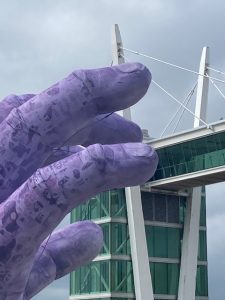
Part of the delightfully weird Squonk at the Davenport Skybridge on Aug. 21.
Two-thirds of all tourism in the U.S. is driven by arts and culture, he added. “Cultural tourists spend twice as much when they are visiting. Think of a place you want to visit or a place you want to move, and odds are they have a great art community — whether it’s murals ad sculptures, museums and galleries, music in public spaces, performances and theater.”
Younger workers are putting greater emphasis on the arts when they decide where to live and work, Maynard said. “In short, everyone wants to live in a cool place. And arts and culture is the ticket to get there.”
Quad City Arts helped up the “cool” factor in the QC during last month’s four-day Alternating Currents Festival, in downtown Davenport, Rock Island and Moline. The nonprofit organized the popular Silent Disco and Squonk, in and around the Davenport Skybridge.
As part of its public art program, Quad City Arts is reaching out to neighborhood residents to get their input on what art they want to see in their area.
The Downtown Davenport Partnership has formed a public art committee and has a placemaking plan, also including art in infrastructure designs. Moline recently adopted a public art and placemaking plan that makes “significant investments” in arts, including public funding — and spending 2 percent of capital improvement projects on arts, as well as 1 percent in private development along identified corridors.
“It’s a bold plan and Moline leadership should be commended for it,” Maynard said.
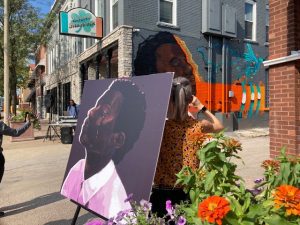
A new mural, painted by a Rock Island High junior, Riley Jones, was unveiled last month at 313 20th St., Rock Island.
He recommended that the public make financial commitments to local arts groups and artists; attend free and paid events, and help promote the arts through social media and word of mouth.
“Support local artists — buy their art, purchase their album, tip the band that’s playing at your favorite bar,” he said. “Also, let’s end the idea of creating or doing something for exposure. Let’s pay artists their worth — remember, there’s a reason you reached out to them to play at your event, create your logo, etc. They add value to your business.”
Quad City Arts and the Chamber partnered on the Riley Jones mural and through that partnership has raised money for an additional mural, through grants and donations. “At this time, we know we will be doing one more mural, and it is highly likely that we will be doing more than one. Murals and public art accomplish a lot in a community,” Maynard said, adding:
- They beautify an area, and not just with the art. Often times other beautification tasks following including better lighting, trash cleanup, etc.
- Public art is welcoming. It can set the tone for a community or an area.
- Similar to above, it can express the values of a community.
- Public art is proven to increase civic pride.
- Public art and the arts in general drive local traffic, tourism, business development, and make people want to live in a community.
Creating an unforgettable sense of place
Dave Herrell, president/CEO of Visit Quad Cities, is another major champion for keeping the gas on that placemaking train – “strategically and creatively positioning your community to add value for residents to drive a high quality of life experience,” he said recently by e-mail.
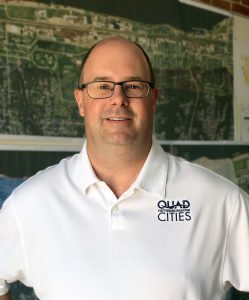
Dave Herrell is president/CEO of Visit Quad Cities.
“Placemaking also ideates and develops cities and destinations to demonstrate their authenticity, brand, and story to emotionally connect with a variety of audiences including but not limited to locals, visitors, and businesses,” Herrell said. “Placemaking transforms communities and destinations to compete for people attraction and relevancy in a hyper-competitive marketplace. The stronger and more vibrant a place is to visit this will make a place worthwhile to live. And, if the stronger and more vibrant a place is to live, this will make a place worthwhile to visit. They are uniquely interconnected.”
Destination development and creating a meaningful sense of place “is the most critical component of destination management and marketing as well as tourism,” he wrote. “The only way communities grow and build themselves to become viable is if the private and public sectors align for the betterment of all.
“Placemaking strategy and execution is a common theme throughout Visit Quad Cities Tourism Master Plan and Destination Vision for the future. It is a key priority,” Herrell said. “It is also an emphasis in our strategic operating guide ‘River Pilot’ and annual business plan.
“Understanding that public art and placemaking drive economic development and position us for the future,” he said. “The momentum that our Quad-Cities regional destination downtowns have right now is positive and we need to keep up this important work and execute. Plans that sit on shelves don’t create community building value for anyone so we need to continue to advocate for quality of place.
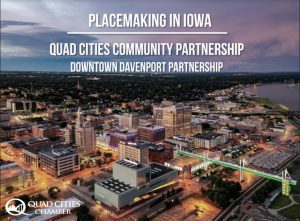
A photo of downtown Davenport on a presentation on placemaking.
“Each downtown and city has its own distinct characteristics and traits and we can use these to our collective advantage,” Herrell said. “In addition, we have an incredible creative energy in our region and talented creatives who are shaping this energy. They need our support if we are to strengthen our creative economy. Moreover, there are some strong non-profits, organizations, and institutions that are doing some fantastic work in this space.
“Couple this with municipalities that are paving the way for transformation is what excites us from a marketing activation perspective,” he said, noting the QC should be “recognized internationally as a must-experience riverfront destination.
“The only way this works is if we have a unified regional riverfront development vision and master plan on both sides of the Mississippi River,” Herrell said. “There needs to be consensus for this with all public sector partners and the business community if we are to fully activate and leverage our world-renowned global asset. In addition, Visit Quad Cities and the Quad Cities Chamber’s soon-to-be-released regional brand initiative will be an opportunity for us to capitalize on as we think about our regional brand image and messaging.
“Image and perception are critically important to our success and we need to invest in them because our competitors are daily,” he said. “I am excited about this project because I believe it can be the spark we need on a lot of fronts.
“Understanding and behaving as one region so that our community’s culture is collaborative, inclusive, and non-duplicative,” Herrell said. “The only pathway forward for us to improve is to end the parochialism. Healthy competition can be beneficial, but we must continue to have robust communication and a positive civic spirit among all municipalities, counties, and states if we are going to compete in this space.”
Creating a sense of place management in Chamber
Carter, the passionate DDP boss, gained another hat in his career wardrobe about a year ago as he was named the Chamber’s vice president of place management services. That means he oversees each of the chamber’s downtown organizations, including DDP, the Downtown Bettendorf Organization, and nascent Downtown Rock Island Partnership, to which Jack Cullen was named director this past April – an actual organization and funding vehicle for downtown projects haven’t been put together yet.

Downtown Davenport Partnership executive director Kyle Carter.
Carter recently gave a presentation on placemaking to the Iowa Chamber Alliance, and he noted downtown Davenport has had an organization in place far longer than any other of the Quad-Cities, since 1976. Its special taxing district, under Iowa law, is called a Self-Supported Municipal Improvement District, or SSMID. It’s a tool communities in Iowa can use to help fund public improvement and maintenance projects within a specified area.
SSMID funds are created through an additional tax placed on property owners in the defined district, only established after enough property owners show their support through a voluntary petition process.
It wasn’t until July 2019 that the Bettendorf City Council approved the creation of SSMID in downtown Bettendorf. Fifty-eight percent of all commercial, industrial and multi-residential property owners representing 70 percent of the assessed value within the district petitioned the city of Bettendorf to request creation of the SSMID.
The City of Bettendorf contracted with the Quad Cities Chamber, which has experience managing the SSMID funds in Davenport through the DDP, to help determine if there was enough interest from downtown property owners to create a SSMID. In Illinois, a similar process is called a Special Service Area, which is in downtown Moline, but hasn’t been adopted in downtown Rock Island yet.
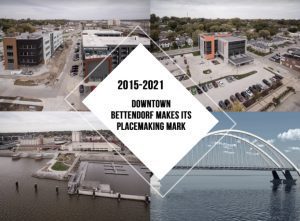
Improvements to downtown Bettendorf.
Place management (which DDP does) includes core areas of business and economic growth; infrastructure and livability, and advocacy and promotion.
“When property owners are taxing themselves extra dollars to help go above and beyond, we are the group that administers those dollars,” Carter said. “It’s grant dollars, financial assistance for facades. It’s managing the flower baskets, make sure the area is clean and safe, where public art, programs, government advocacy, festivals, events, business intelligence and economic development work, all that stuff lives underneath that hood.”
Placemaking is the creative part of the process, that leverages unique cultural and social assets that define a community’s identity, he said. “For us, it’s about workforce, talent retention, attraction and really being creative in how you celebrate the soul of a community.”
“The placemaking in general is leveraging all these unique assets. You have to tell your story and make quality of life that people actually may want to enjoy and stay and live in your town,” Carter said, noting that place management is the “forever work” of administering the programs and maintaining the key assets.
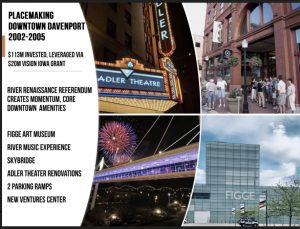
State funding helped downtown Davenport undertake major improvements, like the River Music Experience and Figge Art Museum.
“Placemaking is the real creative element of it. It’s River Renaissance. It was people getting together in Davenport years ago and saying we’re going to build an art museum,” he said.
“We’re going to build a place to celebrate music and a skybridge. And we’re going to build all these assets in parks, in public spaces and that are also partially private spaces. That is really the truly creative collective work.
“I think it was put really well the other day by Kevin and by Tyson about how this is, this is really a shared effort,” Carter said. “I think it’s all collaborative. I mean, none of this works independently. They’re all interdependent on relationships with City Hall, with property owners, with the public, with artists, with business owners. Like there’s not a piece of this stuff isn’t collaborative. Placemaking has been going on for eons, but the term is taking on greater emphasis and urgency around the world in recent years, he said.
“It’s shared between the public and private sectors,” Carter said. “So I think the term placemaking is more of a newer term in the last couple of years. And place management is taken directly from the box from the International Downtown Association.”
His recent presentation to the Iowa Chamber Alliance on placemaking drew a direct line over the last 20 years to how downtown improvements have not only boosted quality of life, but drive up local and state tax revenues.
“We funded River Renaissance. We built the River Music Experience,” Carter said. “We attracted bands, like Grace Potter and the Nocturnals, who played here four or five times. They end up at the Adler Theatre, we start building a music scene, things like Daytrotter and other independent venue start to grow. And then our downtown food and beverage and entertainment industry, and tax base grows like that.

The new Kaiserslautern Square was unveiled Sept. 17 in downtown Davenport
“You can draw a straight line from 20 years ago to that and that is the definition of a place making,” he said. “The work is never done, which is why we have a place management organization here to keep the wheels turning, ‘cause this stuff takes decades.”
He was especially pumped about the renovation and rebirth of Kaiserslautern Square – celebrated in an opening Sept. 17, in the public space next to Duck City Bistro on East 3rd Street.
“That weekend was a huge effort toward making and owning our space,” Carter said. “There’s nowhere else in the world that has that little pocket park. It’s unique completely, and so how do we program that and make it special and authentic is the fun part, right? That’s the creative
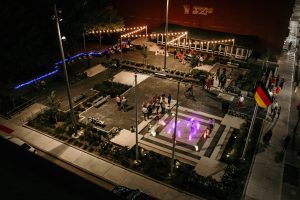
The new Kaiserslautern Square was unveiled Sept. 17 in downtown Davenport
element, that Tyson and Kevin spoke so eloquently about.”
“When you do it best, it’s a process that really touches base with the people in the community, in a particular geography that when you make improvements, whether they be through physical infrastructure or events or both — that it celebrates the culture and the people who are there and what makes it special and these are the things that attract workforce,” he said.
“When you look at the really 30,000-foot level of how we going to fill jobs in the Quad-Cities and why does somebody want to move to Rock Island or Davenport or East Moline and who currently lives in Georgia, Michigan or California?” Carter said. “These are the things that

The new Kaiserslautern Square was unveiled Sept. 17 in downtown Davenport.
people, that stand out to somebody looking at your community. It’s all of these elements that are the first point of contact for someone’s interest in your community.”
Among the public art – a new committee started under DDP, and a key placemaking tool — Davenport is starting an alley rehabilitation program downtown, starting with cleaning up and beautifying alleys behind the Forrest Block and Danceland, Carter said.
“We will get some murals painted, and some lighting, both for safety and for fun, and using the arts in a way that will make these actually interesting,” he said, pointing to the great Johnnie Cluney “Davenport postcard” mural added to the Iowa end of the Government Bridge in summer 2017. “So it’s one thing to repaint, that’s great. It’s a lot more interesting to make it a place you actually want to spend time,” Carter said of adding life to neglected downtown areas.
“I think Moline has really been a leader in this and we’re not there yet,” he said of public art. “But I think it would be great to see that everywhere else in the community having the arts be a fundamental part of economic development. That’s something we’ve said for years, largely based off our success with River Renaissance.”
Implementing plans in Moline
The city of Moline is the first in the QC to have a formal Public Art and Placemaking Plan, since the long-range plan was adopted recently by the City Council.
The $50,000 plan was funded primarily by The Moline Foundation, and was completed under the direction of Renew Moline in cooperation

The cover of the Moline Public Art and Placemaking Plan.
with the city. A nine-member Public Art Steering Committee (formed in late 2019) guided the consultant selection and recommended Designing Local, based in Columbus, Ohio, which led the process.
“The City has a rich tradition of supporting and assembling an extensive collection of public art that includes, among other things, fountains, sculptures, murals. The City has long understood the aesthetic, placemaking, and place-defining value of public art, the cultural importance of public art, and the contributions to promoting a higher quality of life for City residents that public art provides,” according to the ordinance adopted by the council.
“However, the City’s public art collection has been mostly supported and assembled informally, without a coordinating plan and set of policies,” it says. “The City, understanding the importance that public art plays in promoting a higher quality of life, defining space, and placemaking, thereby promoting broader City-wide economic development goals and objectives, desired to establish a more formal public arts program, with systems and policies to provide a financing mechanism and overall coordinating plan to promote and facilitate public art installation on public and private properties in key areas of the City.”

A new Mercado on Fifth sign was unveiled Sept. 24 by Mercado director Anamaria Rocha and Moline city administrator.
Placemaking was a key term uttered Friday by new Moline city administrator Bob Vitas, when he congratulated Mercado on Fifth and its partners for introducing a new colorful sign on its outdoor property near 5th Avenue and 12th Street.
“Arts and placemaking are part of the city’s plan and our agenda,” Vitas said at Friday’s unveiling, attended by leaders from Mercado, Quad Cities Chamber, Moline Foundation and Greater Quad Cities Hispanic Chamber. “We have a new Public Arts Commission being created. This is probably one of the finest examples of public art in downtown Moline today. Congratulations to everybody who was engaged in this project.”
Manis said recently that adding public art for downtown Moline comes at a perfect time, with the I-74 bridge completion.
“It’s important to now think about how to incorporate public art, rather than get it all developed and oh, it’s an after-thought,” he said. “This is as exciting as any policy that’s ever passed through the city of Moline, ever. It’s gonna be a game-changer, for sure.”
Placemaking encompasses far more than public art – including landscaping, festivals, developments like John Deere Commons and Bass
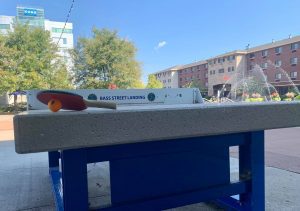
Bass Street Landing is off 17th Street and River Drive, Moline.
Street Landing, Manis said. In May, he also unveiled a placemaking example — Moline Centre partnered with Black Hawk College’s Highway Construction Careers Training Program to create a one-of-a-kind interpretation of a parklet prototype at Lagomarcino’s — a 24-foot-long wooden bench and platform on the street, hugging the sidewalk.
“Parklets have been proven to stimulate revenues for businesses they complement; increase foot traffic throughout the business district they’re incorporated into; calm traffic, spur new business growth, and create a warm, welcoming, vibrant and safe atmosphere for residents, employees and families as they interact with Main Street districts across America,” Manis said then.
He’s also excited about the renovation of the John Deere Pavilion (at 15th Street and River Drive), a huge tourist attraction that’s been closed since March 2020. “That is the most important space that families, business travelers, tourists, anybody can interact with that, for free,” Manis said. “It’s been shut down since the pandemic started.”
From Moline Centre’s perspective (which also has a special service area), he wants to get creative with use of those dollars. “Development has happened; the stage is set. Now it’s time to decorate the stage,” he said. “To complement with murals, or make sure the sculpture pads that got put into the development never sit empty.
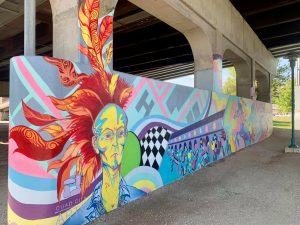
A view of a new mural under the Arsenal Bridge in downtown Moline.
“The goal is to continue to partner with organizations like Quad City Arts, and River Music Experience,” Manis said, noting music is big in creating a cool, creative, attractive vibe.
Placemaking is vital, as a “really cool welcome sign,” he said. “When it’s carefully placed and carefully executed and designed, it becomes a magnet for destination.”
“It’s to make our business community, business district in downtown Moline, as attractive to anyone coming to the Quad-Cities, or lives in the Quad-Cities,” Manis said. It not only helps draw businesses and residents, but it makes residents proud to live here.
“We’re on the dawn of hiring a new economic development director,” he said, which will help implement the public art master plan. The mayor is appointing a Public Art Commission, Manis noted.
For Renew Moline, placemaking is an effort to creatively reimagine public spaces in a way that “deeply connects the community to the places they share,” Alexandra Elias and Liz Nolte of Renew wrote Friday by e-mail.
Placemaking capitalizes on assets specific to the community that become “beloved.” Put another way, “it is magnetic in drawing people to visit, live, work and play. Anyone who has traveled to another city and has memories of an organized activity or event or an attractive public

Renew Moline president/CEO Alexandra Elias.
space has experienced ‘placemaking,’” Renew said.
“Placemaking has always been a part of Renew Moline’s work, but in recent years, city planning and economic development thinkers have connected placemaking with positive economic outcomes for a city,” Elias and Nolte wrote. “As the region works to attract and retain young talent, we see placemaking as fundamental to creating a city where people love to live.
“The Q-C is well on its way to a cohesive and widespread effort to increase placemaking and public art. Each of the cities is doing interesting things with special events, art, music, experiences and outdoor activities,” they said. “The Public Art & Placemaking Plan that was recently adopted by the City of Moline is visionary, ambitious and—perhaps most importantly—has a clear path to funding projects.
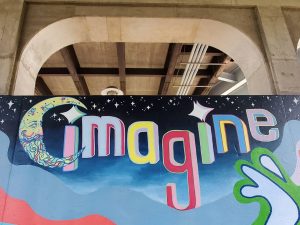
A detail of a new mural in downtown Moline, under the Arsenal bridge.
“The Mayor and Council should be commended for their confidence in the city’s future.
As future placemaking efforts evolve, there’s always room for improvement in working as a whole Quad-Cities—creating a regional destination that can be defined as a catalyst of amazing and vibrant places to go, see and do,” Renew said.
“There are no bounds to what creative placemaking can bring to the Quad-Cities. We need to be open to new ways to create meaningful experiences for all Quad Citizens, regardless of age, physical ability, income or any other characteristic.”
“We believe that each city is unique, but each has an opportunity to reflect shared influences as the Quad-Cities has a rich history tying us all to the Mississippi River,” Renew said. “In the future, we hope for stronger partnerships and shared ideas that can elevate each city’s unique culture. We need to be able to collaborate without boundaries, and assist each other as one region.
“As Renew and the City embark aggressively toward implementation of public art and placemaking projects, we will learn more about best practices; and we are happy to share our experience and expertise with others (organizations, elected officials, staff and other communities),” Elias and Nolte wrote.
Renew posted Sept. 23 on Facebook: “We have a once-in-a-lifetime opportunity to create an amazing space along our riverfront in the I-74 Corridor. Don’t miss your chance to share your ideas!” You can join this first meeting this Tuesday by registering here: www.renewmoline.com/big-ideas/.
Betting on a revitalized Bettendorf
One of the most obvious placemaking efforts is literally connecting Moline and Bettendorf – the long-planned $1.2-billion I-74 bridge, the largest, newest Q-C landmark now under completion.

The new $1.2-billion bridge and reconstruction of I-74 is a new Q-C landmark.
The big Bridges apartment complex and TBK Bank have opened right next to the new bridge, and the booming, ever-expanding TBK Bank Sports Complex is another major destination in Bettendorf, with several restaurants, entertainment, retail and lodging options. Ryan Jantzi, executive director of Downtown Bettendorf Organization, said placemaking is what makes home special.
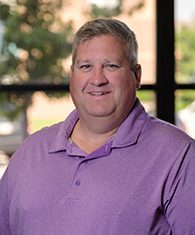
Downtown Bettendorf Organization executive director Ryan Jantzi.
“It is our identity, our history, our passions, and our love of place that can help create a unique space, artwork, and/or sculptures within our community,” he said by e-mail.
“Placemaking is vital in creating a strong community by strengthening our community pride and by helping tell our community’s story,” Jantzi said. “A thriving downtown is a place where people live, work, shop, visit, and play. It is not only a place to visit and do business but is also becoming home to a growing population.
“Placemaking in the form of public art and pocket parks are a vital part of our success in creating a thriving downtown,” he said. “By adding pocket parks and public art to our downtown we are helping break up the urban jungle and in turn are creating a place where people want to

Improvements to downtown Bettendorf.
spend time, invest, and/or live. Placemaking is economic development.
“Our biggest asset in the QC is the Mississippi River. The Quad-Cities does a good job of celebrating the river and the rich history of this region,” Jantzi said. “The QC community needs to continue to collaborate to find even more ways to enhance this natural wonder.
“In the case of downtown Bettendorf, continued collaboration between invested stakeholders, citizens, elected officials, and city staff will lead towards a stronger community. The new I-74 Bridge will have an urban park underneath her,” he said. “This park will create connectivity between downtown and the neighborhood to the north, as well as connectivity, for the east and west sides of our downtown.
“Historically the old I-74 was a divide within our urban core,” Jantzi said. “By working with the city and invested stakeholders, we can create an urban park that will be valuable in helping create a downtown environment that attracts investment, fosters our community pride, and provides a gathering place for our visitors and residents.
“Continued communication and collaboration is the key,” he said. “How can we create better spaces that are attractive, well-maintained, funded, and valuable to our residents? By communicating with one another to find the best practices. It is important for all the Quad-Cities to grow together. It is not about one city out doing the other, it is about the Quad-City region. If we continue to work together, we can create a prosperous Quad-Cities where all can thrive.”
Bringing back the Rock Island Arts & Entertainment District
Downtown Rock Island was the first in the area to promote its core as “The Arts & Entertainment District” for the region. Through business closings, the brutal Covid pandemic and other changes, some of the luster has vanished and Cullen is working with the Chamber and downtown stakeholders to restore its once-bustling sense of place.

A Metro Arts vinyl wrap display at 1808 2nd Ave., Rock Island.
“Place management is key for us as we’re looking to create a new organization in partnership with the city and downtown property owners that provides place management services for downtown Rock Island,” he said recently.
Place management includes everything from business attraction/retention and routine beautification/maintenance to hospitality/public safety and downtown marketing/special events, such as the live jazz show on the Great River Plaza Sept. 18 in collaboration with RME and the downtown business community.
“Placemaking is more about the enhancement of public and private spaces through collaborative projects, such as new murals, decorative lighting, signage, banners, pocket parks, activated alleyways – elements that give people that sense of place when they visit a vibrant commercial neighborhood,” Cullen said.
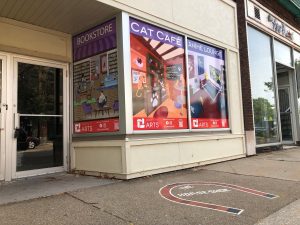
A Metro Arts vinyl wrap display at 1608 2nd Ave., Rock Island.
“In downtown Rock Island, we’re excited about the launch of the mural program in conjunction with QC Arts that started with the Riley Jones mural, the new storefront art initiative we launched in partnership with QC Arts and plans to activate Arts Alley in the 1700 block of 2nd Avenue,” he wrote by e-mail.
Arts and culture building is key to revitalizing downtown Rock Island, Cullen said.
“We’re working with our Downtown Steering Committee of property owners, city officials and nonprofit partners to identify the services that will be provided by the organization and the funding model to make it happen,” he said. “Business attraction and filling available spaces is a major priority for the group, being that our primary focus is to facilitate business growth through providing special services for the downtown area.
That was a goal with this past summer’s Metro Arts project with Quad City Arts, to create vinyl wraps for windows of vacant commercial spaces at 1808 2nd Ave., and 1608 2nd Ave. It was a collaboration with Black Hawk College student graphic designers, a lead artist, Edwards

Downtown Rock Island director Jack Cullen.
Creative and property owners to market those spaces in a new way.
“The images depict what the students would like to see downtown,” Cullen said.
Since the summer of 2000, Metro Arts has provided area youth 15-21 years old with paid summer apprenticeships in various arts disciplines. The program provides opportunities for youth and enhances the community through the arts.
For five weeks, area youth work together in groups to complete art projects under the supervision and mentorship of professional artists. Throughout 2020, Quad City Arts was evaluating its mission and how they served the community. Accessibility became a focal point due to the pandemic, forcing arts organizations to reevaluate how we were delivering programs, Maynard said.
“In recent years, Metro Arts has had an increase in requests for murals, which is great, but the mural program can be inaccessible to many students,” he said. “Some students do not have access to arts classes in their schools and not all of them can afford private lessons.
“In 2021, we wanted to focus on programs that were designed from the ground up to be more accessible programs,” Maynard said. With that in mind, one of the programs created was the graphic design program under the direction of lead artist Annie Oldenburg, apprentices learned the basic concepts of the Adobe Creative Cloud.
The final project was a storefront vinyl project in Downtown Rock Island where apprentices created designs to go on windows of vacant storefronts that included ideas they would love to see in our community. “These vinyl wraps help draw attention to these great spaces,” Maynard said.
Black Hawk College provided the use of their facilities as well as the use of their equipment, highlighting their support for the arts, education, and the community.
“Quad City Arts and their Metro Arts program plays such a crucial role in spreading art and creativity throughout the Quad-Cities,” Oldenburg said. “This program not only awards young adults the chance to share their artistic voices, but it is also a chance for them to see that they can get paid for their art and to shine a light on potential career opportunities.
The Graphic Design program of Metro Arts was given a prompt to work with, re-envisioning empty interior spaces. Each artist was encouraged to think about the values they wanted to embody in this community display. “Collectively, the group wanted to celebrate diversity
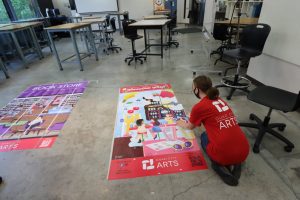
Metro Arts apprentices working in graphic design at Black Hawk College.
(age, disability, race, culture, gender) and create spaces that promoted community gathering: an art collective where makers can come together to create, a community center with free meals and beds, or a library with different sensory experiences,” she said.
“Our mission at BHC is to provide the environment and resources for individuals to become lifelong learners,” Oldenburg said. “Our art lab is the perfect environment for this: we have a lot of the technology these artists might find in a design firm, including iMacs, large-format printers, Wacom Tablets, and the full Adobe Creative Suite. These artists also gained less tangible benefits that will continue to aid in their arts development: artist critiques, group work and team-based design, and experience with creative problem-solving.”
Zaiga Thorson, the BHC art department chair, said part of the college mission is to partner with other organizations in the community.
“As a long-time resident and artist living in Rock Island, I know the incredibly impact that Quad City Arts has had on the entire region,” she said recently. “The outreach and programming they do with young people, in particular, through Metro Arts and visiting artists in the schools plays a crucial role in the development of not only creativity, but critical thinking, problem solving and team building.
“At BHC, we had the facilities, software and expertise to help QCA develop a graphic design component to Metro Arts,” Thorson said. “It was truly a win-win for both of our organizations. There are many career opportunities for creatives today, particularly if they can combine the qualities mentioned above with technological skills.”
Cullen said in downtown Rock Island, there’s also excitement around American Bank & Trust opening a new branch downtown, YWCA breaking ground on its major facility and the new federal courthouse planned, after demolition of the former Bituminous building across 4th
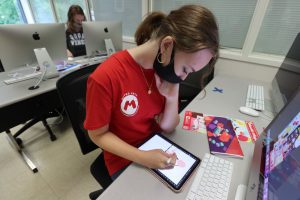
A Metro Arts apprentice works at the Black Hawk College computer lab.
Avenue (and 18th Street) from the empty Argus building.
“Those developments and others, coupled with some exciting grant opportunities, Downtown TIF funds and federal Covid relief funds to make major enhancements to public spaces, and the creation of this downtown organization make for a bright future in downtown Rock Island,” Cullen said.
The goal is to have the new downtown place management organization set up with sustainable funding by the beginning of 2023.
Last month’s mural unveiling off 20th Street also as the official kickoff to the Alternating Currents festival Aug. 19-22 in the Quad-Cities.
The art was spray-painted recently on the south side of 313 20th St., Rock Island, of the former Lucky Shamrock bar, done by Rocky junior Riley Jones, in collaboration with professional muralists Dana Harrison (Limone) and Brandon Warner (ASPHATE).
The new mural is an adaptation of Jones’s artwork originally titled “Black Pride,” which also was displayed at the August event, held by the Quad Cities Chamber and Quad City Arts as part of Alternating Currents. A winner of the 2021 Congressional Art Competition, the original piece was selected by U.S. Rep. Cheri Bustos (who represents Illinois’ 17th District) to be displayed at the U.S. Capitol this summer.
“We thought if it’s good enough to be in D.C., in the walls of the U.S. Capitol, it’s good enough to be on a wall in downtown Rock Island, on a wall in Riley’s hometown,” Cullen said then. “We’re really excited about this project.
“It’s amazing, because it’s not only supporting a young, talented artist in our community. But it really furthers the conversation around racial equity and racial justice in the Quad-Cities. And it’s part of a larger revitalization project in downtown Rock Island.
“We’ve seen in other communities that murals can really help brighten dark spaces in downtowns, and generate more foot traffic,” Cullen said. “It also gives more attention to other areas that weren’t noticed previously. That’s what we’re trying to do here. In the process since this project began, it’s totally encompassed everything we’re trying to do in revitalizing downtown Rock Island. It’s encouraged more investment in this area, this alleyway and an adjacent vacant lot – being able to attract one new business to one of the storefronts here.”
This project marks the launch of a new mural program in Downtown Rock Island being led by Quad City Arts and the Chamber through its new partnership with the City of Rock Island.









